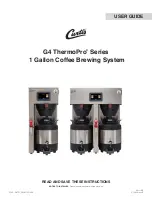
9
PARTS LIST / CIR-O
ITEM QTY
PART NO.
DESCRIPTION
1
2
BUG-1996
Fixed Leg & Wheel Assembly
2
3
BUG-1998
Adjustable Leg & Wheel Assembly
3
5
BUG-2010
Wheel w/Bearing
4
1
BUG-2407
Post Assembly (Vertical)
5
1
BUG-2440
Base Post (Block)
6
1
BUG-2915
Torchholder Assembly
7
1
BUG-5100-F
DC III Drive Unit Assembly (150:1)
120 VAC 240 VAC BUG-5102-F
42 VAC- BUG-5104-F
8
4
CIR-9002
Offset Leg & Magnet Foot (Optional)
9
4
CIR-9020
Magnet Foot
10
4
CIR-9021
Leg (Specify Length w/Suffix)
Lengths Available: 5" (127 mm)
8" (203 mm) 10" (254 mm)
11
1
CIR-1010-3
Twin Hose Assembly 32" (812 mm)
42" (1066 mm) CIR-1010-4
50" (1270 mm) CIR-1010-5
12
1
CON-(3,4,5)000 Ring & Gear Assembly
13
1
CON-(3,4,5)041 Carriage Plate
14
4
CON-1003
Leg-2" (50 mm)
15
1
CON-1042
Center Pin Support Bar
16
1
CON-1043
Center Pin Assembly 9" (228 mm)
17
3
FAS-0986
Fit Hd Soc Sor 5/16-24 x 5/8
18
2
FAS-2736
Fil Hd Set 10-24 x 2-1/4
19
1
GOF-3025
2-Hose Quick-Acting Manifold
20
1
HOB-1025
Rack Stop
21
1
PAN-1015
Rack 22-5/8" (574 mm)
22
1
PAN-1033
Rod Clamp
23
1
PAN-1043
Spacer
24
2
WAS-0230
#10 Washer
CIR-O / PARTS LIST
16
The purpose of the
TEMPLATE KIT
is to permit cutting of elliptical and
obround holes. The manner of accomplishing this job involves dragging the
torch barrel against a template which is made 11/16" (18 mm) larger on the
radius than the cut-out desired (when using standard US machine torches).
The
TEMPLATE KIT
consists of a master layout template (aluminum sheet),
which is used to locate the bolt holes and center on the actual template which
should be made from 1/8" (3 mm) masonite or similar material.
A full-size drawing of the shape to be cut, should be made showing a center
point, then add 11/16" (18 mm) to the radius. (Because the torch body drags
against the template, adding one-half the diameter of the torch to the drawing
will put the center of the torch tip in the right position.)
MAKING THE TEMPLATE
Lay the aluminum master layout template on the masonite board. Transfer
the holes from the master by tracing with a pencil or use a quick-drying spray
paint. Next, position the oversized drawing, so that the center point is directly
over the center on the template and the shape is located symmetrically be-
tween the ‘leg holes’ (see sketch Page 17, number 8. Trace [or spray] the
outline onto the template.)
Next, drill the holes in the template. Then, cut-out the outside circle (outside
of the template) and the shape to be cut (on the inside).
MOUNTING THE TEMPLATE
The four CIR-9031 spacer legs should be screwed into the ring gear. (Remove
existing 2" (50 mm) legs.) The template is then placed on these legs and the
2" (50 mm) legs, or 5" (127 mm) legs, when using the recommended CON-
1040 leg and foot assemblies) are screwed - through the template - into the
CIR-9031 spacer legs, which clamp the template under and parallel to the
ring gear. Insert four round head screws (see sketch Page 17, number 12)
through the template - into the alignment bars (see sketch Page 17, number 7.)
SET UP
Place the rod [see sketch Page 17 number 5 in the base post on the carriage.
Slip the tensioning assembly (see sketch Page 17, number 6) on the rod.
Install machine torch in torchholder - make sure torch is straight up-and-down
in both planes. Adjust tensioning assembly so that torch maintains firm contact
with template when carriage is rotated. Connect hoses. Place machine on
work - locate feet and lock in position.
STARTING THE CUT
Lock tensioning assembly so that the torch tip is over scrap area, piece - or
start the cut in starting hole. When preheat is complete start motor (carriage
travel), release tensioning assembly and let it gradually swing to template -
(this action ‘feathers’ the start into the cut.)
TEMPLATE KIT







































